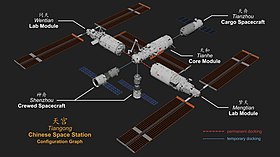
Back Chinese groot modulêre ruimtestasie Afrikaans Estación Espacial Chinesa AN محطة تيانجونغ الفضائية Arabic থিয়েনকুং মহাকাশ স্টেশন Bengali/Bangla Vesmírná stanice Tchien-kung Czech Chinesische Raumstation German Τιάν-γκονγκ Greek Ĉina kosmostacio Esperanto Estación espacial Tiangong Spanish Tiangong espazio estazioa Basque
 A rendering of the station with the Tianhe at centre of picture, a Tianzhou on its aft port, the Wentian on its starboard port to the left, the Mengtian on its portside port to the right and two Shenzhou spacecraft, sharing its multi-docking hub | |
| Station statistics | |
|---|---|
| Crew | Maximum: 6[1] Currently aboard: 3 (Shenzhou 18) Expedition: 7 Commander: Ye Guangfu (PLAAC) |
| Launch | 29 April 2021 (Tianhe) 24 July 2022 (Wentian) 31 October 2022 (Mengtian) ~2025 (Xuntian) |
| Launch pad | Wenchang Spacecraft Launch Site LC-1 |
| Mission status | Operational |
| Mass | ~ 100,000 kg |
| Length | ~ 55.6 m[2] |
| Diameter | ~ 39.0 m |
| Pressurised volume | 340 m3 (12,000 cu ft) Habitable: 122 m3 (4,310 cu ft) |
| Periapsis altitude | 386.4 km[3] |
| Apoapsis altitude | 391.8 km[3] |
| Orbital inclination | 41.47°[3] |
| Typical orbit altitude | 389.1 km[3] |
| Orbital speed | 7.67 km/s[3] |
| Orbital period | 92.3 minutes[4] |
| Days in orbit | 1120 days, 19 hours, 26 minutes (23 May 2024) |
| Days occupied | 990 days, 5 hours and 5 minutes (23 May 2024) |
| Statistics as of 25 April 2024 | |
| Configuration | |
 Station elements as of April 2024 (exploded view) | |
Tiangong (Chinese: 天宫; pinyin: Tiāngōng; lit. 'Sky Palace'),[5][6] officially the Tiangong space station[7] (Chinese: 天宫空间站; pinyin: Tiāngōng kōngjiānzhàn), is a permanently crewed space station constructed by China and operated by China Manned Space Agency.[8] Tiangong is a modular design, with modules docked together while in low Earth orbit, between 340 and 450 km (210 and 280 mi) above the surface. It is China's first long-term space station, part of the Tiangong program and the core of the "Third Step" of the China Manned Space Program; it has a pressurised volume of 340 m3 (12,000 cu ft), slightly over one third the size of the International Space Station. The space station aims to provide opportunities for space-based experiments and a platform for building capacity for scientific and technological innovation.[9]
The construction of the station is based on the experience gained from its precursors, Tiangong-1 and Tiangong-2.[10][11][12] The first module, the Tianhe ("Harmony of the Heavens") core module, was launched on 29 April 2021.[5][6] This was followed by multiple crewed and uncrewed missions and the addition of two laboratory cabin modules. The first, Wentian ("Quest for the Heavens"), launched on 24 July 2022; the second, Mengtian ("Dreaming of the Heavens"), launched on 31 October 2022.[10]
- ^ Cite error: The named reference
shenzhou15_6was invoked but never defined (see the help page). - ^ 朱光辰 (2022). "我国载人航天器总体构型技术发展". 航天器工程. 第31卷 (第6期): 47. Archived from the original on 16 February 2023. Retrieved 21 February 2023.
- ^ a b c d e "The orbital parameters of the core module assembly". China Manned Space. 20 September 2021. Archived from the original on 27 July 2021. Retrieved 27 July 2021.
- ^ "To infinity and beyond: After Space Station, China has plans for a kilometer-long mega spaceship". India Today. 8 September 2021. Archived from the original on 24 April 2022. Retrieved 8 September 2021.
- ^ a b Cite error: The named reference
sfn-20210429was invoked but never defined (see the help page). - ^ a b "China launches space station core module Tianhe". Xinhua News Agency. 29 April 2021. Archived from the original on 29 April 2021. Retrieved 29 April 2021.
The Tianhe module will act as the management and control hub of the space station Tiangong, meaning Heavenly Palace
- ^ Cite error: The named reference
cmse201311was invoked but never defined (see the help page). - ^ Cite error: The named reference
crewwas invoked but never defined (see the help page). - ^ ChinaPower (7 December 2016). "What's driving China's race to build a space station?". Center for Strategic and International Studies. Archived from the original on 4 January 2017. Retrieved 5 January 2017.
- ^ a b Cite error: The named reference
nsf20210301was invoked but never defined (see the help page). - ^ "中国载人航天工程标识及空间站、货运飞船名称正式公布" [CMSE logo and space station and cargo ship name officially announced] (in Chinese (China)). China Manned Space Engineering Office. 31 October 2013. Archived from the original on 4 December 2013. Retrieved 29 June 2016.
- ^ Ping, Wu (June 2016). "China Manned Space Programme: Its Achievements and Future Developments" (PDF). China Manned Space Engineering Office. Archived (PDF) from the original on 5 July 2016. Retrieved 28 June 2016.
© MMXXIII Rich X Search. We shall prevail. All rights reserved. Rich X Search